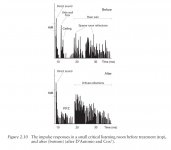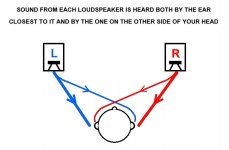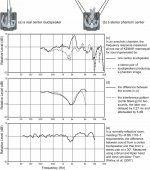Oh, and feeding the miniDSP 2x4HD with the USB instead of analog input sure helps a lot! I don't trust that double conversion at all (AD-DA)
Mine is smaller which may or may not be a good thing for stability. The base is 245mm (W) by 315mm (D)
If you keep the center of gravity very low and put something massive (say 10mm / 3/8'' thick steel or stainless steel laser cut plate) you will be able to reduce the footprint to a minimum while keeping the speaker stable. Like the inflated clown toy we had in our childhood 🙂
An externally hosted image should be here but it was not working when we last tested it.
That clown.
But don't make any speakers based on that design, they will sound funny.
You can give them to me, i find tc9 great sounding...your finding is suspicious.
2 pair in the door prizes today (mine) for diyFEST + Madisound has donated 2 pr of TG9.
Come on by & get some raffle tickets 🙂
dave
For bass, sure. But why would it need to be for mids and highs?Jon, open baffle should be 4-5 ft away from wall.
I have, thank you. Should I expand my question? I've built measured and heard a lot of OB speakers.
No 😀 It's about having enough delay between the direct and reflected image.....but, you see, I'm with Linkwitz on the psychoacoustics and blah blah blah...😉
I have, thank you. Should I expand my question? I've built measured and heard a lot of OB speakers.
Pano, they (he?) defend the position where time delay caused by having an OB too close to the wall will deliver flawed sonic results.
I've been playing with my OB prototype non-stop today and besides changes in FR i didnt notice said flawed sonic results. Maybe in a concrete-walled room ?
Like i said at the beginning, the higher you cross the OB's driver, the less surrounding walls causes problems. Full OB (bass), that's another story, but i'm sealed+OB now...
This Powerpoint presentation might explain why one would like more time between the direct wave front and the reflected energy: http://www.davidgriesinger.com/Acoustics_Today/Pitch,%20Timbre,%20Source%20Separation_talk_web_sound_3.pptx
It isn't that the music becomes unlistenable. You may even like what you hear. But the intelligibility will get worse. Your brain will have a harder time to separate sources.
But... if you enjoy it, just go ahead and place them close to a wall, why not?
Reading the presentation in the link will make you aware of the consequences of that decision, but it cannot tell you to stop enjoying the sound you hear. 🙂
It isn't that the music becomes unlistenable. You may even like what you hear. But the intelligibility will get worse. Your brain will have a harder time to separate sources.
But... if you enjoy it, just go ahead and place them close to a wall, why not?
Reading the presentation in the link will make you aware of the consequences of that decision, but it cannot tell you to stop enjoying the sound you hear. 🙂
How about a test? If intelligibility becomes a problem, could that be tested with speech? If the speech is not in your first language, that might be even better.
A single voice isn't the challenge. In the document I linked there is talk about separation, and being able to keep two or more separate sounds apart. Griesinger talks from a different point of view, yet it is applicable to/for our hobby. At least, it depends on what you want out of it. We probably can state that we don't all have the same goals.
A song like David Bowie's "Ashes to Ashes" comes to mind. That's a song with deeper layers, partly consisting of spoken words while the main voice has it's own continuing stream.
No need to prove anything though. It may matter what the listener's own personal goals are. But if one is counting on the OB's capability of a figure '8' type of radiating pattern to avoid reflections, it would not be fitting with that concept to place it close to reflecting boundaries as it would be sort of counter productive.
Will we hear it as separate sound? Of course not, not in such a small time frame, but it will probably obscure the finer detail captured in the recording. If that's important or not is up to the one placing the speakers in a room or choosing for a certain concept.
I'm not against it, but I wouldn't do it myself... I have different goals. Keeping the first ~6 ms relatively clean like was suggested is pretty good advise in my humble opinion.
A song like David Bowie's "Ashes to Ashes" comes to mind. That's a song with deeper layers, partly consisting of spoken words while the main voice has it's own continuing stream.
No need to prove anything though. It may matter what the listener's own personal goals are. But if one is counting on the OB's capability of a figure '8' type of radiating pattern to avoid reflections, it would not be fitting with that concept to place it close to reflecting boundaries as it would be sort of counter productive.
Will we hear it as separate sound? Of course not, not in such a small time frame, but it will probably obscure the finer detail captured in the recording. If that's important or not is up to the one placing the speakers in a room or choosing for a certain concept.
I'm not against it, but I wouldn't do it myself... I have different goals. Keeping the first ~6 ms relatively clean like was suggested is pretty good advise in my humble opinion.
...but it will probably obscure the finer detail captured in the recording...
Time smear.
dave
Sure, for music. But if it's for a TV or cinema, public address, etc then it's a major factor.No need to prove anything though. It may matter what the listener's own personal goals are.
I'd be interested in knowing if pushing the OB back near the wall hurts intelligibility. I did some reading on how that' tested, and it usually lists of words. But I agree that isn't what's really needed here. Maybe words mixed into music or crowd noise would be a good test for us.
If you keep the center of gravity very low and put something massive (say 10mm / 3/8'' thick steel or stainless steel laser cut plate) you will be able to reduce the footprint to a minimum while keeping the speaker stable. Like the inflated clown toy we had in our childhood 🙂
My base is about as small as possible and the speaker itself on top is heavy enough without needing to add extra mass.
There is no reason why an OB speaker very near boundries can't still sound good. I think adason's point was more that reflections within 6ms will be integrated by the ear together and won't be heard as separate by the brain.
What that does is colour the sound so it is not as pure as it could be. Depending on the speaker and setup it could make it sound subjectively better, but when going for ultimate accuracy the bigger distance makes sense.
Think of it like putting a driver in a small sealed cabinet with no damping. It doesn't mean it will sound terrible but most people stuff their cabinets to assist in damping the rear wave energy. Not exactly the same but a similar principle.
The other thing with your setup is that if there is a large magnet behind a small driver and the cutout in the baffle is restrictive it is very possible that the rear radiation is not as strong and the dipole effect is reduced.
Maybe some background will help:
Reflections can have a very seductive quality. Keeping the first ~6 ms clear will allow us to get a good grip on the vocal parts in the recording.
The Haas limit (where reflections get lumped in with the direct sound and experienced as one event) is even longer, though it is somewhat dependent on frequency and the longer time frame will still work for sounds below ~3.5 KHz.
In a Studio Haas Kickers have been popular quite a while ago. Over time they were mostly abandoned as a studio concept, some say because everything started to sound a little better. Those Haas kickers came in somewhere between 15 and 25 ms. Diffused in nature and arriving laterally they can actually add something positive for perception and imaging.
An example of the Haas kicker:

(bottom picture) also known as ISD termination.
The first ~15 to 25 ms having a clear lower level of reflections is most commonly known as a reflection free zone.
For the pleasure of listening at home, having those later (but still early arriving somewhere between 15 to 25 ms) reflections can be a very persuasive thing to have. At least I am not bothered by everything sounding a little better and use extra speakers, making sure they are diffused in nature, as a virtual Haas kicker.
Even later arriving reflections outside of the Haas limit can still add something to our perception. This is described as giving a sense of envelopment, something you'd find in good quality venues. Much lower in level and arriving as late as 150 ms after the main wave front they will be perceived as separate by our brain.
David Griesinger has a lot of info on that subject on his website and scattered around the web.
Relative early reflections, somewhere between 6 ms and 15 ms might actually have a positive effect for Stereo in the phantom center, enhancing the intelligibility according to the writings of Floyd Toole. They are said to fill in the dips of the stereo cross talk (left speaker canceling direct sound at the right ear and vice versa). Something (the cross talk) that becomes more obvious if we remove/reduce all early reflections.

Stereo cross talk
A measurement by Floyd Toole showing the effects of Stereo cross talk in a normally reflective room and compared to anechoic conditions:

The top graph shows the difference of running an actual center speaker compared to a phantom center as created by stereo. The bottom graph is showing the slight reduction of the dips as seen in the top anechoic measurement due to room reflections filling in those dips in our stereo environment.
Most papers I've read agree that the very early reflections (below about 6 ms) should best be avoided or at least be minimized to get the most out of stereo. Whether that should stop anyone from placing speakers closer to boundaries because they enjoy it that way remains an entirely free choice.
Reflections can have a very seductive quality. Keeping the first ~6 ms clear will allow us to get a good grip on the vocal parts in the recording.
The Haas limit (where reflections get lumped in with the direct sound and experienced as one event) is even longer, though it is somewhat dependent on frequency and the longer time frame will still work for sounds below ~3.5 KHz.
In a Studio Haas Kickers have been popular quite a while ago. Over time they were mostly abandoned as a studio concept, some say because everything started to sound a little better. Those Haas kickers came in somewhere between 15 and 25 ms. Diffused in nature and arriving laterally they can actually add something positive for perception and imaging.
An example of the Haas kicker:
(bottom picture) also known as ISD termination.
The first ~15 to 25 ms having a clear lower level of reflections is most commonly known as a reflection free zone.
For the pleasure of listening at home, having those later (but still early arriving somewhere between 15 to 25 ms) reflections can be a very persuasive thing to have. At least I am not bothered by everything sounding a little better and use extra speakers, making sure they are diffused in nature, as a virtual Haas kicker.
Even later arriving reflections outside of the Haas limit can still add something to our perception. This is described as giving a sense of envelopment, something you'd find in good quality venues. Much lower in level and arriving as late as 150 ms after the main wave front they will be perceived as separate by our brain.
David Griesinger has a lot of info on that subject on his website and scattered around the web.
Relative early reflections, somewhere between 6 ms and 15 ms might actually have a positive effect for Stereo in the phantom center, enhancing the intelligibility according to the writings of Floyd Toole. They are said to fill in the dips of the stereo cross talk (left speaker canceling direct sound at the right ear and vice versa). Something (the cross talk) that becomes more obvious if we remove/reduce all early reflections.
Stereo cross talk
A measurement by Floyd Toole showing the effects of Stereo cross talk in a normally reflective room and compared to anechoic conditions:
The top graph shows the difference of running an actual center speaker compared to a phantom center as created by stereo. The bottom graph is showing the slight reduction of the dips as seen in the top anechoic measurement due to room reflections filling in those dips in our stereo environment.
Most papers I've read agree that the very early reflections (below about 6 ms) should best be avoided or at least be minimized to get the most out of stereo. Whether that should stop anyone from placing speakers closer to boundaries because they enjoy it that way remains an entirely free choice.
Attachments
Last edited:
An externally hosted image should be here but it was not working when we last tested it.
An externally hosted image should be here but it was not working when we last tested it.
Worst-case scenario enough?
OB with 18FH500 + 3FE22, against the wall.
Will try with and without the foam tiles (positionned lower)
I think I shall be the winner of this challenge. Muhahahaha!

Read more here: Corner Floor-to-Ceiling Line Array Using Vifa TC9
The face width is only 6 inches. It's an equilateral triangle.
I had some audio friends over yesterday. Couple of them are reviewers for 6Moons and Positive Feedback. They were quite impressed and I got comments like, "With this setup, you can basically tell Stereophile to go **** themselves!" This was the first time other audiophiles heard the system, so, I'm glad they liked it.
Read more here: Corner Floor-to-Ceiling Line Array Using Vifa TC9
The face width is only 6 inches. It's an equilateral triangle.
I had some audio friends over yesterday. Couple of them are reviewers for 6Moons and Positive Feedback. They were quite impressed and I got comments like, "With this setup, you can basically tell Stereophile to go **** themselves!" This was the first time other audiophiles heard the system, so, I'm glad they liked it.
- Status
- Not open for further replies.
- Home
- Loudspeakers
- Multi-Way
- The minimum footprint challenge


